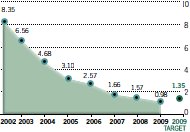Health & safety
Health and safety are absolute priorities for Lafarge. The Group has implemented a stringent safety policy for its employees and subcontractors. It also participates in public health programs that benefit both employees and local communities.
Lafarge aims to be among the safest companies in the world and encourage safe behavior.
Safety: The top priority |
|
|
Lafarge is the safest company in its sector. Since 2002, the Group has achieved a significant reduction in both the frequency and the gravity of work-related accidents. These improvements are due in part to the Group's Health and Safety management system, which defines the minimum safety levels required for all Lafarge sites.
A great deal remains to be done to become one of the safest industrial groups in the world. For this reason, employee safety is the Group's n°1 priority.
To reach its target of zero fatal accidents and keep lost time injuries to a minimum, Lafarge:
Lafarge intended to halve its lost-time injury rate compared to 2005, and to achieve a 1.55 rate by 2008. Since such good progress was made in 2007, the Executive Committee agreed to set a tougher target for 2009 of 1.35.
|

Worker at the quarry at Sénas in the South of France Targeting zero accidents
Tula: an exemplary worksite The construction site of the new cement plant at Tula, in Mexico, is exemplary: the lost-time injury rate was 11 times lower than the national average. "Throughout the 20 months of this construction project, 800 workers put in a total of 3 million hours. We applied the principle of zero tolerance in safety matters", said Maximo Dolman, managing director of Lafarge Mexico from 1999 to January 2006. "We had to mobilize local subcontractors, who often take a relaxed approach to safety, and encourage them to change their mindset."
TestimonialDyfrig James, Managing Director of Aggregates in the United Kingdom, discusses safety |
Supporting work-related health for all employees |
|
The Group’s golden rulesHealth and safety: top priority All Lafarge employees are committed to respecting certain rules to ensure the greatest levels of health and safety within the company.
The 11 rules of Health & Safety
(P.D.F - 44 Kb)
|
The availability of suitable tools and the deployment of preventive principles have produced positive results: work-related illnesses are rare.
Lafarge is not complacent about the good results it has achieved. As part of Sustainability Ambitions, Lafarge is going to establish a comprehensive occupational health program by 2010, with regular medical exams for all of its employees. In February 2009, a doctor was hired to undertake this task.
|
The fight against HIV/Aids and malaria |
|
|
Lafarge has first-hand experience of the ravages caused by HIV/Aids and malaria, particularly in the sub-Saharan countries where it operates. The Group quickly became involved in efforts to prevent and treat the illness with the support of specialized doctors and organizations such as the Care. Lafarge is also a member of the Global Business Coalition, which works to fight HIV/Aids and malaria.
As a result, in 2008, in sub-Saharan Africa where Lafarge employs around 8,000 people (almost 10% of its employees):
The anti-malaria program began in 2006. In 2007, Lafarge provided malaria treatment for 17,500 people (employees, dependants, sub-contractors and community members).
By 2010, these efforts against HIV and malaria will be extended to the other major developing countries where Lafarge operates.
|
|





